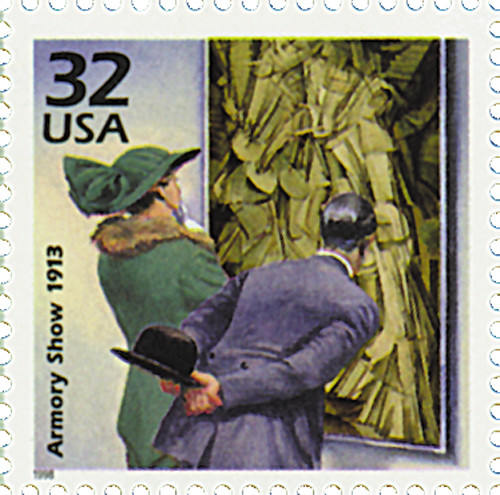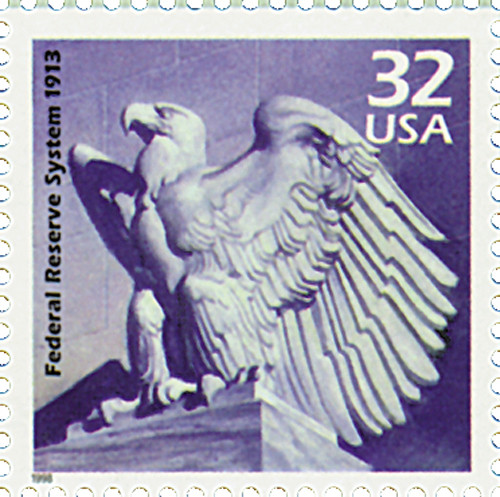
# 3183o - 1998 32c Celebrate the Century - 1910s: Child Labor Reforms
US #3183o
1998 Child Labor Reform – Celebrate the Century (1910s)
• Part of the second sheet in the Celebrate the Century stamp series issued from 1998-2000
• Honors child labor reform efforts of the 1910s
• Includes text on the back with historical details
Stamp Category: Commemorative
Series: Celebrate the Century
Value: 32¢ First Class Mail Rate
First Day of Issue: February 3, 1998
First Day City: Washington, DC
Quantity Issued: 188,000,000
Printed by: Ashton Potter (USA) Ltd.
Printing Method: Offset, Intaglio
Format: Panes of 15
Perforations: 11.6
Tagging: Block Tagging
Why the stamp was issued: Commemorates Congress’s attempts to reform child labor laws during the 1910s.
About the stamp design: Pictures an oil painting of a child in a factory by artist Dennis Lyall. Includes the following text on the back “Child Labor Reform Lewis W. Hine’s photographs of children working in mines, mills, and factories led Congress to try to regulate child labor, but the Supreme Court declared early laws unconstitutional.”
First Day City: The First Day of Issue Ceremony was held in Washington, DC, with legendary radio and television host Larry King as master of ceremonies.
About the Celebrate the Century series: The USPS launched the Celebrate the Century series in 1998 to mark the end of the 20th century and herald the arrival of the 21st. The series includes 10 sheets of 15 stamps (150 in total), with each honoring important moments from a different decade (1900s, 10s, 20s, 30s, 40s, 50s, 60s, 70s, 80s, and 90s). At the time of completion, it was the longest and most ambitious commemorative stamp series in US history.
History the stamp represents: Major changes regarding child labor in the United States are an important part of the nation’s social and economic development. There were earlier reforms and regulations, but it was not until this century that national child labor standards were established and enforced.
Children have worked to help support their families since ancient times. In early America, children helped with the farming, handiwork, and trades which were essential to colonial life. Child labor did not actually become a social problem until the development of industries and factories. Children could be paid lower wages, were less likely to cause labor troubles, and had small fingers for machinery work. By 1900, about two million American children under the age of 16 were working. However, they often had jobs which required adult strength. Many of these children worked in factories, mills, and mines under dangerous and unhealthy conditions.
In 1904, a group of concerned citizens formed the National Child Labor Committee. They helped bring the problems of America’s child workers to the public’s attention. State laws began to be enforced, and other child labor committees were organized. In 1916, the first federal child labor law was passed by Congress.
US #3183o
1998 Child Labor Reform – Celebrate the Century (1910s)
• Part of the second sheet in the Celebrate the Century stamp series issued from 1998-2000
• Honors child labor reform efforts of the 1910s
• Includes text on the back with historical details
Stamp Category: Commemorative
Series: Celebrate the Century
Value: 32¢ First Class Mail Rate
First Day of Issue: February 3, 1998
First Day City: Washington, DC
Quantity Issued: 188,000,000
Printed by: Ashton Potter (USA) Ltd.
Printing Method: Offset, Intaglio
Format: Panes of 15
Perforations: 11.6
Tagging: Block Tagging
Why the stamp was issued: Commemorates Congress’s attempts to reform child labor laws during the 1910s.
About the stamp design: Pictures an oil painting of a child in a factory by artist Dennis Lyall. Includes the following text on the back “Child Labor Reform Lewis W. Hine’s photographs of children working in mines, mills, and factories led Congress to try to regulate child labor, but the Supreme Court declared early laws unconstitutional.”
First Day City: The First Day of Issue Ceremony was held in Washington, DC, with legendary radio and television host Larry King as master of ceremonies.
About the Celebrate the Century series: The USPS launched the Celebrate the Century series in 1998 to mark the end of the 20th century and herald the arrival of the 21st. The series includes 10 sheets of 15 stamps (150 in total), with each honoring important moments from a different decade (1900s, 10s, 20s, 30s, 40s, 50s, 60s, 70s, 80s, and 90s). At the time of completion, it was the longest and most ambitious commemorative stamp series in US history.
History the stamp represents: Major changes regarding child labor in the United States are an important part of the nation’s social and economic development. There were earlier reforms and regulations, but it was not until this century that national child labor standards were established and enforced.
Children have worked to help support their families since ancient times. In early America, children helped with the farming, handiwork, and trades which were essential to colonial life. Child labor did not actually become a social problem until the development of industries and factories. Children could be paid lower wages, were less likely to cause labor troubles, and had small fingers for machinery work. By 1900, about two million American children under the age of 16 were working. However, they often had jobs which required adult strength. Many of these children worked in factories, mills, and mines under dangerous and unhealthy conditions.
In 1904, a group of concerned citizens formed the National Child Labor Committee. They helped bring the problems of America’s child workers to the public’s attention. State laws began to be enforced, and other child labor committees were organized. In 1916, the first federal child labor law was passed by Congress.














